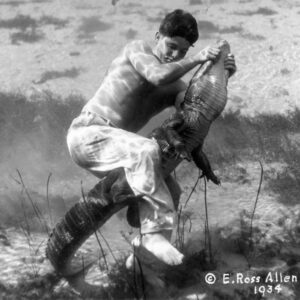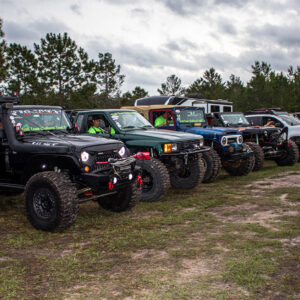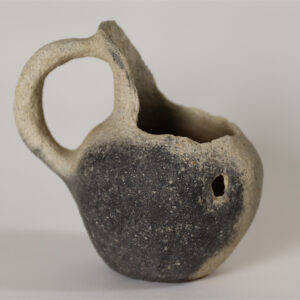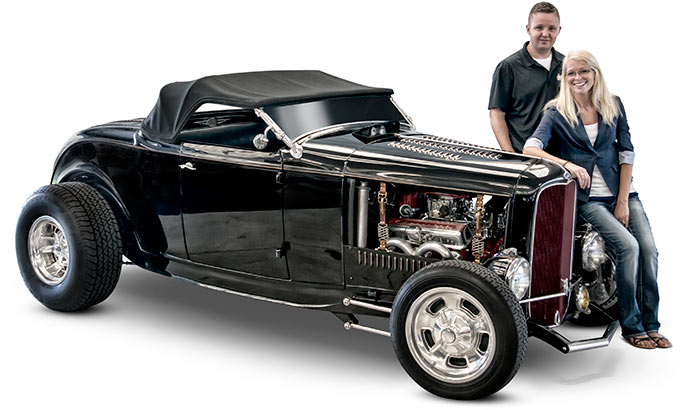
Classic car enthusiasts definitely know what it’s like to fall in love, even though the focus of their affection is an inanimate object. They’re passionate, inspired and detail-oriented. They put their money where their hearts are, and they’re proud of it. They don’t mind admitting that nostalgia plays a role in their obsession, but in a world where so much is unpredictable and disturbing, that’s not hard to understand.
“What makes a car ‘collectible’ is not as much about the car as about how you feel when you’re around it. You’re relaxed and in the moment, not thinking about the troubles of the world,” says John Duggan, an avid car collector, restoration buff and founder of The Ocala Pumpkin Run, a classic car show and fall festival.
“Nostalgia has a lot to do with it. Everyone wants a piece of their past. People tend to think yesterday was better than today, so they relate neat cars with good memories,” says Duggan. “I know someone who collects station wagons. You might ask, ‘Why?’, but it’s all about what people grew up with. They remember going to the beach with the family or going to the drive-in with a date.”
“I remember when I was 12 years old, washing my brother’s 1970 Corvette coupe before he went out on a date,” recalls Peter Bartlett, operations director of The Ocala Pumpkin Run, who spent 35 years managing large auto dealerships. “Back in that era, if you had one of those, it was ‘the bomb.’”
“Many people collect cars as art,” adds Duggan. “Once you look at cars that way, you won’t look at them the same again.”
“A lot of people enjoy the beauty of a classic car. It takes you back to when those cars were made,” says Brittanie Hart, who agrees that nostalgia is part of the appeal.
Brittanie and her husband, Josh, own Burnyzz American Classic Horsepower in Ocala. Burnyzz has a 17,000-square-foot showroom of classic and collectible vehicles, plus a full-service repair and body shop. At any given time, the shop has 60 or more classic cars available for sale; customers often ask them to find a specific car.
As Brittanie explains, part of what makes collecting so exciting is that no two cars are identical… even if they’re the same make and model.
“Every car is so unique. You can put one ’55 Bel Air next to another and they’ll be different. People also do a lot to make classic cars like new, such as putting in power steering and power brakes, even a new engine. You can do just about anything to customize them.”
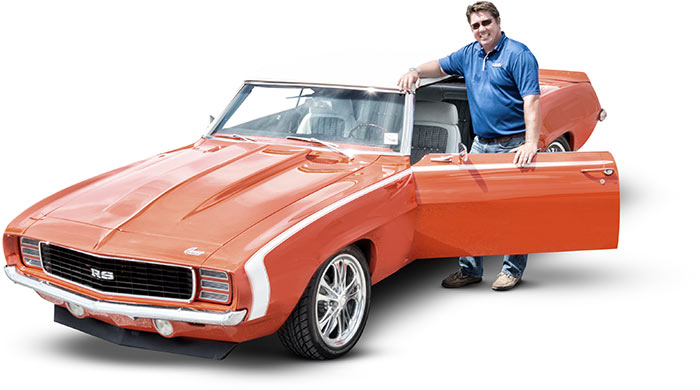
Passion Behind The Pursuit
Prominent car collector and enthusiast Jay Leno says any car can be a collector car… if you collect it. It may not be rare, but if it puts a smile on your face and it’s fun to drive, you may only have to spend a few thousand dollars to take home a little bit of history you can enjoy working on.
Leno may be a celebrity, but for him—and many other collectors—much of the appeal is uncovering the story behind the car. He likens the hunt for a classic car with the plot in a Harlequin novel. Dreaming about what might be and the potential of uncovering a “diamond in the rough” inspire many a collector, just like a woman reader turning the pages of a romance novel, eager for the happily-ever-after ending.
A great story might actually be the deal maker or breaker for buying the car. He once bought a 1951 Hudson Hornet from a widow in her 90s. The car had been the only vehicle she and her husband had owned. When Leno walked into the garage, it was obvious that the car, which had over 260,000 miles on it, was worn out, from a mechanical perspective. But physically it was all there and intact; every receipt had been saved in the glove compartment. Leno bought the Hornet but says he was really buying the story more than the actual car.
Car collectors come from all walks of life and professions. Lifelong friendships are often created between people who don’t have anything else in common but their love of cars. As Duggan puts it, “one collector may be a doctor who buys a car, while the other is a mechanic who builds his from scratch, but they both have a classic car.”
For Fred Lambes of High Springs, Florida, cars are not just a passion. They’ve been his entire career. From his first job as a young teen pumping gas, Lamb worked his way up to working in a body shop, becoming a mechanic and eventually owning his own auto repair business. He owned and operated Tom’s Cars used car lot in Ocala with partner Tom Hemingway for 25 years. The business closed in January of this year after Hemingway passed away and Lambes retired.
“I’ve worked on cars since I was 15 years old,” says Lambes, whose pride and joy is a ’55 Chevrolet Bel Air he bought in 2008 and spent over three years restoring. “It was just a rolling chassis and body when I bought it. There was no engine. I enjoy making things better than they originally were, and what’s better to do that with than an older vehicle that didn’t have the technology of today?”
Lambes prefers to restore and modernize, something collectors refer to as “resto-mod.” The original ’55 Bel Air didn’t have cruise control or air-conditioning, but Lambes’s does now.
“I stripped it down and started from scratch. It has all the creature comforts of today but the look and feel of the ’50s,” explains Lambes. “I’m all about extreme attention to detail. The best thing about restoring an old car is the satisfaction it gives me, and I also like taking them to shows.”
Lambes’ latest project is a ’69 Chevy half-ton step-side pick-up truck, a vehicle he remembers driving as a kid. And yes, the story behind it was part of the appeal.
“This truck was originally a fleet vehicle for a nuclear test site in Nevada. There was only one other in-between owner, so I’m just the third owner,” he grins. “When you’re looking for a classic car, you look for one with a good foundation. The best place to start is a state where there’s no snow, so there’s no rust. Arizona, Nevada, Texas and California tend to be good states to buy cars from.”
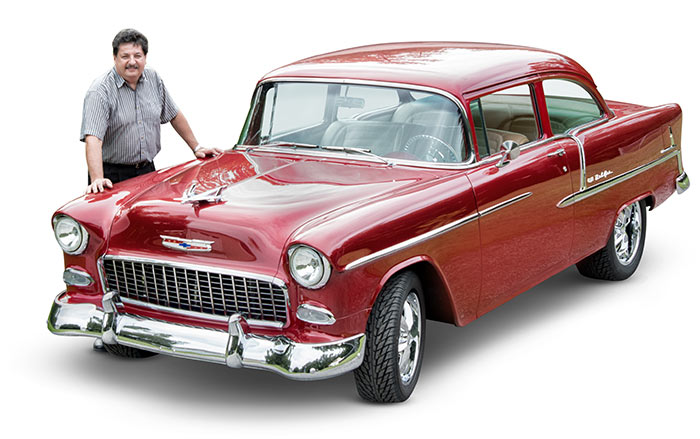
Put A Little Muscle Behind It
Even if you’re not a collector, you’ve likely heard the term “muscle car,” some of the automotive world’s most sought-after collectibles.
The original muscle cars were sexy and sharp with plenty of chrome and far more engine than necessary. Typically produced between 1965 and 1973, they boasted a mid-sized, wide-profile frame with a gas-guzzling V8. These American-made cars were two-door sports coupes that delivered a high-performance driving experience. Classic examples include the Dodge Charger, Chevrolet Corvette, Pontiac GTO, Buick GS, Chevrolet Chevelle and Pontiac Trans AM.
To give an idea of just how popular muscle cars were when they first hit the market, Pontiac hoped to sell 5,000 of their new GTOs in 1964 but ended up selling 32,450. Ford debuted the Mustang in 1965 and sold close to 1.5 million models in just two years. (Purists may argue that the pony car isn’t a true muscle car, but no one can doubt its popularity.)
The muscle car era was short-lived, a fact that adds to the cars’ cult status and collectibility today. Leaded gas was banned in 1973, and the federal government got tough on emission controls. Also in 1973, the OPEC oil embargo dramatically affected gas prices and availability. Insurance premiums also jumped due to the vehicles’ excessive horsepower.
“Back in the muscle car days, fuel economy wasn’t an issue,” notes automotive technician Matt Gibbs, who has owned Sonrise Automotive in Ocala for 20 years. He also hosts a call-in radio show, Auto Repair with Personal Care, every Monday on The Source (96.3FM, 1370AM). “It wasn’t until the 1980s that the federal government stepped in and mandated that auto manufacturers had to get a certain across-the-board fuel economy.”
Gibbs explains that this doesn’t mean every vehicle made by the manufacturer has to get that specific number of miles per gallon. (If that was the case, Chevy would have had to retire the Corvette.) What it means is that the average mileage of all combined models made by the manufacturer has to meet the fuel requirements.
Using Chevrolet as an example, Gibbs explained that the manufacturer added the Chevette to their line. Although it was a fairly low-end car, it was efficient and got high mileage, which allowed the company to continue making the Corvette, although that model couldn’t come close to meeting the mileage mandates. Chevy knew enough customers would want the sports car, despite its fondness for fuel.
Several positive things came out of those government mandates, Gibbs adds. “It caused the three major U.S. auto manufacturers, and others around the world, to step up and start thinking outside the box. Cars became safer and more efficient, so that’s been good for both consumers and manufacturers.”
Change Is In The Air
Seems the “big three” American auto makers have finally realized drivers want more than safety and good mileage. They want to feel something for their cars. That doesn’t mean a complete revival of the muscle car era, but some of the best things about those cars can be seen on today’s newest models.
“A huge trend now is that the big three motor companies have realized there’s a market for classic car looks, and they’re bringing muscle back into our lives,” says Duggan. “Over the last 10 years, millions have been spent on classic cars, and the manufacturers took note of that. Now they’re going back to curvy lines and high horsepower. Manual shifts are coming back big time, and meatier tires are also coming back in style. Air scoops are becoming functional again, and air grabber hoods are coming back. A lot of things have come full circle again because they worked.
“The Mustang of today looks a lot like a ’66 Mustang of yesterday,” adds Duggan. “The pony car has changed like crazy over the last three decades, but suddenly, it looks like it did 30 years ago. You can get the appeal of an old car but with the reliability of a new vehicle.”
“My dream is to have a Dodge Challenger, but I don’t want a Challenger from the ‘60s or ‘70s,” remarks Gibbs. “I want one from today because it has the look from the classic Challenger but all the technology of what’s going in cars today.”
Gibbs adds that modernizing classic cars is popular among folks like Lambes who are currently restoring them.
“These guys who put all the time and effort into restoring these classic cars are putting the new technology in them, like taking an old car that had a carburetor and restoring it with fuel injection.”
As someone who makes a living working on vehicles, Gibbs finds the advancement in technology over the past decades nothing short of incredible.
“It started with a horse and a buggy. Look how far we’ve come in just 100 years, in just a few generations. It makes you wonder where we’ll be in the next 100 years. Will it be, ‘Beam me up, Scottie,’ like in Star Trek?”
Cars with on-board computers didn’t come out until the mid-1980s. Although it’s been said that older cars are easier to work on because they aren’t computerized, Gibbs points out that this doesn’t mean early models were necessarily simplistic.
“One of my customers has an all-original ’55 Ford Fairlane he brought into the shop. The manufacturer used a vacuum motor to operate the windshield wipers, which wasn’t very efficient but was still very technical. It took a lot of effort to make those windshield wipers work! I enjoy seeing how the engineers and manufacturers thought over 50 years ago.” (For the record, in the process of restoring this particular car, Gibbs and the owner did away with the antiquated vacuum system, replacing it with an electric motor.)
Ocala Pumpkin Run Bigger Than Ever
As the annual Ocala Pumpkin Run 3-Day Fall Festival and Classic Car Show prepares for its fifth year, organizers say the three-day event has at least doubled in size.
Thanks to the great Halloween-themed Family-Fun Area, live music, food and entertainment, the atmosphere is that of a festival, not just a car show.
“It’s good, wholesome family fun all day with something for everyone,” says event founder John Duggan.“We even have the Chainsaw Chix, and Champion Disc-Connected Dogs, and this year we’re adding BMX Trickstars. The whole event has a festival feeling, so even if you can’t relate to the cars, you can still relate to something else at the festival.”
You’ll see cars easily worth half a million dollars, but you’ll also see those worth just a couple thousand. And it’s not just the fancy cars that get all the attention. There’s even a “car corral” with cars for sale, and you won’t have to take a second mortgage out on your house if you’re in the mood to take one home.
For lovers of classic cars, the event is about more than just the cars themselves.
“A car can be priceless to someone because the sentimental value is far above the actual street value,” says Gibbs. “Car collectors enjoy each other’s company, and everyone has a great time getting together. It’s a family thing. Many awesome relationships are built this way.”
Want To Go?
The Ocala Pumpkin Run
October 23-25 @ Castro Farms 7700 NW Hwy 27, Ocala (west of I-75) Gates open daily 8am-4pm
$12 per day, Children 11 and under free
Military discount with ID $10 per day
Free parking (courtesy of Classic Collectors Insurance)
ocalapumpkinrun.com /// (352) 620-9998 /// facebook.com/ocalapumpkinrun

